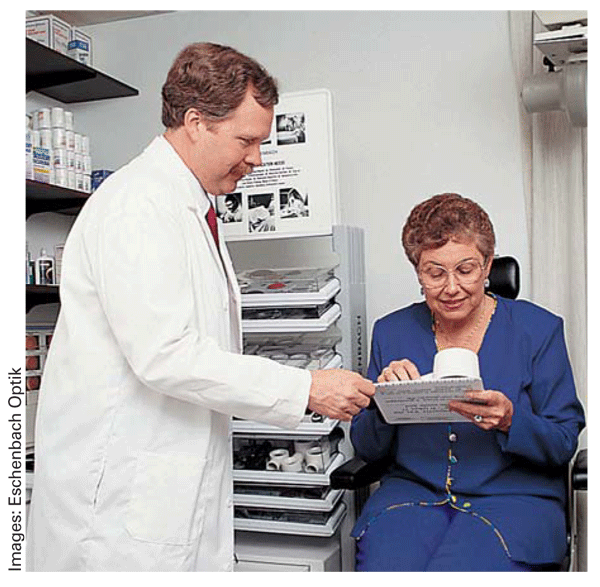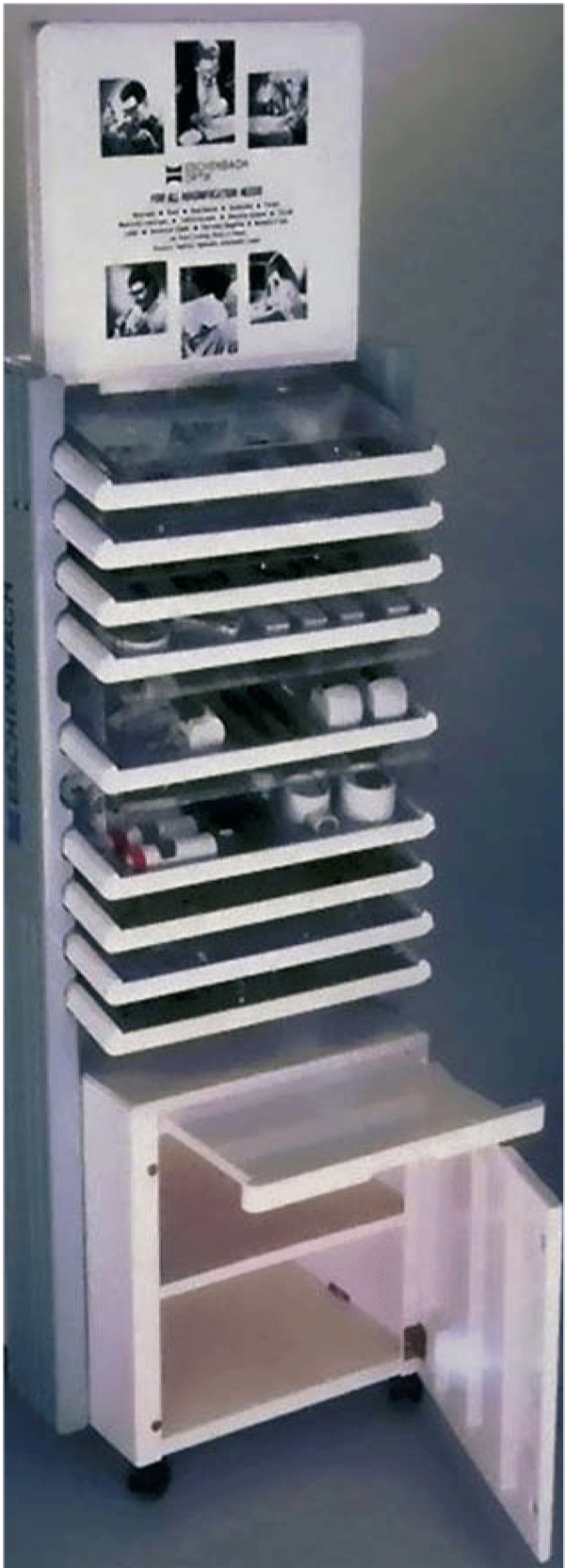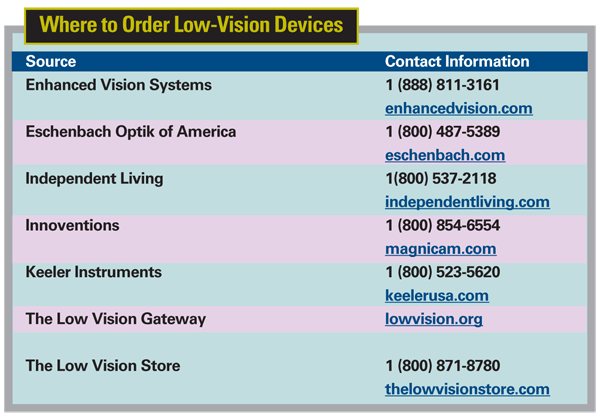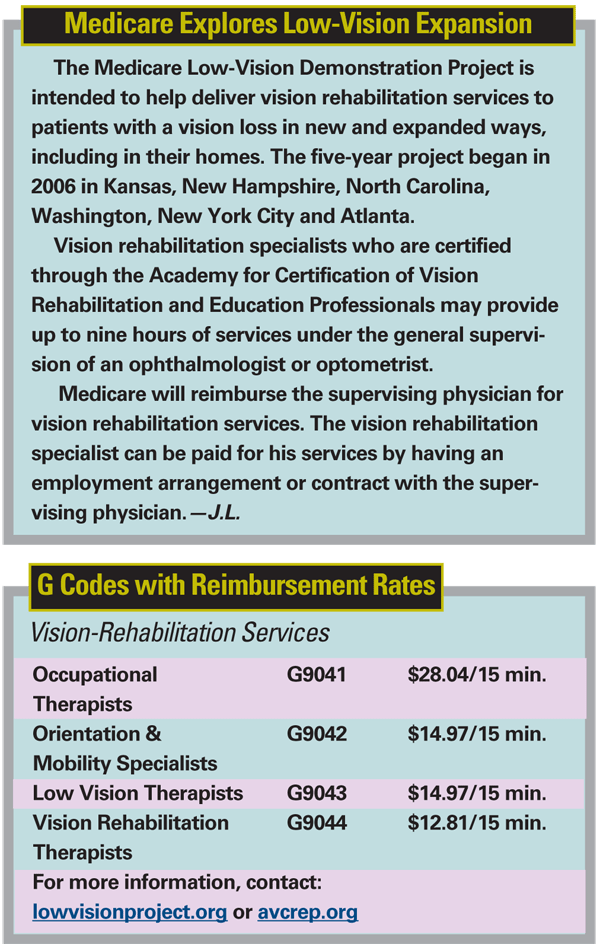Although it may seem far afield from the frame-and-lens business of your optical department, establishing a low-vision service might be the best thing you can add. While normally sighted patients have many sources for eyewear and contact lenses, low-vision patients have few sources for vision-assistive devices—and they often don't know how to find them.
"If the ophthalmologist was aware of [low-vision] resources in the community, that alone would be a godsend. But often, the services are not there," says Jim Deremeik, Education and Rehabilitation Program manager for the Johns Hopkins Lions Vision Research and
Growing Need
The number of low-vision patients is expected to grow dramatically. The Census Bureau projects a doubling of the senior population from 35 million today to 70 million by 2030. The National Eye Institute projects the estimated 9 million Americans with age-related macular degeneration, glaucoma and diabetic retinopathy will grow to more than 13 million by 2020 and may go even higher with an estimated 7.3 million additional people at high risk for vision loss from AMD.
If your practice is located in or near a major city, you may refer your low-vision patients to a rehabilitation center. Mr. Deremeik notes that every state has services for the blind within the state's Department of Education or Department of Rehabilitation. You can also find low-vision centers through the
Remember that mobility and travel are challenging for the visually impaired. If you perform a search and find the nearest low-vision center is more than an hour's travel time away, your visually impaired patients will benefit from services offered by your practice.
"Starting a low-vision service within an existing ophthalmology practice does not have to be difficult," notes Thomas Porter, OD, director of the Low Vision Service at St. Louis University Department of Ophthalmology.
He recommends that you analyze your practice demographics. "Realize that about 5 percent of all patients in a comprehensive practice will benefit from low-vision services," says Dr. Porter. "Next, determine how deeply you want to become involved. Does the practice want to limit services to those in the 20/50 to 20/100 range or to take on every level of vision loss?"
Low-vision consultation can be provided in an exam room or other private area, says Bryan Gerritsen, a certified low-vision therapist at 13 eye-care practices in
Dr. Porter says an investment of $10,000 to $12,000 would provide a comprehensive selection of low-vision devices, but many practices start with much less. "You can begin small and as the patient load increases, expand the diagnostic equipment," he noted.
Staffing is a stickier point. Visually impaired patients need qualified training to succeed with low-vision devices. Your best bet is to connect with a licensed occupational therapist with special training in low-vision rehabilitation, or a CLVT like Mr. Gerritsen and Mr. Deremeik, both of whom earned college degrees in vision rehabilitation.
If you cannot identify a certified or licensed training provider, it may be necessary to grow your own. "There are many practices that identify a technician or optician who will provide many of the low-vision services," says Dr. Porter. "There are a variety of training sources, such as the New York Lighthouse, JCAHPO, various regional conventions and trade shows such as Vision Expo East and West, and low-vision product vendors. There is even on-line training available through
Another option is to transition a retiring physician or optometrist into this role. Currently, Medicare will only reimburse for low-vision services provided directly by a physician, optometrist or licensed OT. There is a pilot program under way in four states and two cities (See "Medicare Explores Low-Vision Expansion," below) that may be expanded to include CLVTs. 
But meanwhile, billing for your homegrown low-vision service provider may require some creative coding, or perhaps you will elect to bill it privately to the patient, just as you would optical services. "There are many very successful low-vision services that operate out of optical departments, charging much like what is done with eyeglasses," notes Dr. Porter.
To establish your fees, Dr. Porter advises you to determine the dollar amount that needs to be generated in a given period of time. "For instance," he says, "if a 30-minute office call generates $100, then a low-vision exam must generate the same income per half hour. The most important thing is to charge in a manner that makes economic sense to the practice."
He observes that a common mistake when establishing a low-vision service is to neglect to educate the entire practice staff. "The practice needs to hold an in-service for every employee," he notes. "Like other professional services, each employee should be able to answer questions and discuss the benefits with patients and families. The staff members who work up patients should be encouraged to identify low vision patients for the doctor." he notes.
Marketing is often overlooked. Be sure to market low-vision services as you do other services; offering low-vision services will probably make the practice unique in your area.
Dr. Porter notes that the biggest mistake doctors make is waiting too long to address the problem with a patient. "When patients' vision falls below 20/50 at near, they begin to lose the ability to perform basic visual tasks," he says. "How independent can patients be if they cannot read personal mail, utility bills, medicine bottle labels, food packaging instructions and a bank statement? Yet, at about 20/50, patients start to have great difficulty with these tasks. Low-vision is not legal blindness!"











